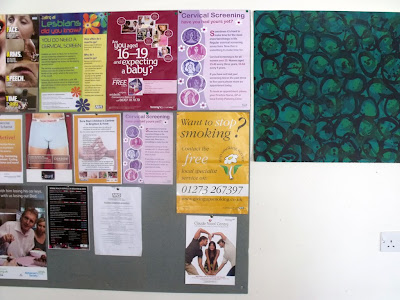Notes from visiting Dutch Specialist:
‘Art Termination’ Guidelines
Early termination:
As long as the artwork itself, a reproduction in any media or any form of reference to an artwork whether spoken word, written, rough sketches has not left the creators personal environment, i.e. the studio, it can be considered as a work in progress and not fully realised. During this period the artist has the right to terminate the work in any stage of creation. The creator can terminate artworks at will. There are NO restrictions during the conceptualisation and creation phase.
In fact termination of unrealised art works is positively encouraged in order to maintain the highest standard for realised work released into the environment. Disposal of the terminated work must be done with care for there have been cases where such work was found, then revived and hung above sofas by so called art lovers. Professional Doctors of Art, who have given a vow of confidence can support the termination process but can only do this on home visits since work to be terminated at no time must be permitted to leave the artists studio.
Termination of the works depends on the particular medium. Best-known methods include shredding, burning, dissolving, chopping, scraping and melting.
Part recycling/organ donation:
Early terminated works and works that are terminally ill can be considered for part recycling. Many methods are available such as melting, dismantling and electronic wiping. Artwork on canvas, wood or other backing media can be part donated through the use of dissolving methods or the use of an eraser to wipe out the visual representations of the picture. Note that picture erasure is a necessary part of the process; otherwise the donated background might ghost and disturb the creation of the new work.
Creative ideas, sketches and concepts can be re-used by the artist or donated, without any media interference, to other artists.
Living will:
A living will is a written statement in which the artwork and human carer declare that the work would like to die through euthanasia in certain circumstances. However this does not guarantee that euthanasia will be performed. There is no such thing as 'a right of euthanasia'. However, this document will certainly made the 'official side of the process' easier, for doctors as well as for artworks. A doctor can prove, after the death of the work, that he performed euthanasia at the explicit request of that work.
There are tree types of living will, each with a different legal status. The documents are highly valued in both the medical and juridical scene. The value for the owner of these documents is therefore a lot higher than his/her own words scribbled on paper. Every artwork and carer should get four copies of the document: one to keep for himself, one to give to his General Art Practitioner, two to give to people who, by proxy, can handle his affairs in case the work lost its capability to do so.
Euthanasia request (active euthanasia): In this document, the work asks the doctor in Arts for a gentle, quick death if time might come in which there is no return to a dignified state of living to be expected. The owner of the document then describes his idea of a dignified state of living. Doctors will only perform euthanasia if the work and carer can confirm the wishes, either in saying or writing, at the time it will be performed. This document solely expresses the wishes of the work. However, if his doctor is willing to perform euthanasia, he will only do so if a document like this is signed.
Refusal of treatment document (passive euthanasia): It is written that an informed consent is necessary for all radical treatments. The Act also says that a written refusal of treatment is equally valid as an oral refusal. With this document, the work and its carer forbids any treatment other than solely based upon pain or oppression relieve if it happens to come in the circumstances in which no return to a dignified life can be expected. Again, the work's ideas of 'dignified life' will then follow. The doctor is warned that if ignores this document juridical action might be taken by, by people authorised by the work and carer. This document has a supplementary section, that regardless the medical expectations, the work refuses all further treatment other then solely based upon pain and oppression relieve. The work states that it sees its life as completed so far, that it forbids medical interventions to prolong life and would like to die a natural way.
'Do Not Resuscitate' (DNR) tag. The 'do not resuscitate' tag forbids under all circumstances every way of resuscitation. The photograph, artist’s signature, name and date of creation of the work are printed in an irremovable, unchangeable way on the tag, so that no doubts about the identity can arise by rescue personnel or doctors.



























